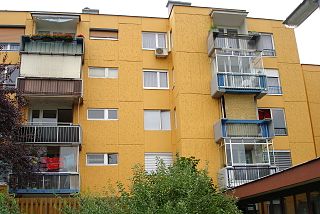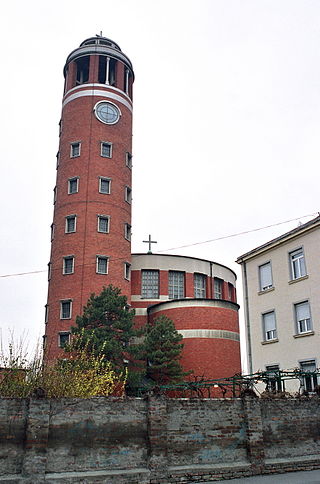
The University of Ljubljana, abbreviated UL, is the oldest and largest university in Slovenia. It has approximately 38,000 enrolled students. The university has 23 faculties and three art academies with approximately 4,000 teaching and research staff, assisted by approximately 2,000 technical and administrative staff. The University of Ljubljana offers programs in the humanities, sciences, and technology, as well as in medicine, dentistry, and veterinary science.

Jože Plečnik was a Slovenian architect who had a major impact on the modern architecture of Vienna, Prague and of Ljubljana, the capital of Slovenia, most notably by designing the iconic Triple Bridge and the Slovenian National and University Library building, as well as the embankments along the Ljubljanica River, the Ljubljana Central Market buildings, the Ljubljana cemetery, parks, plazas. His architectural imprint on Ljubljana has been compared to the impact Antoni Gaudí had on Barcelona.

The Triple Bridge comprises three bridges spanning the Ljubljanica River in Ljubljana, the capital of Slovenia. It connects the historical medieval town on the southeastern bank with the central Prešeren Square on the northwestern bank. Dating back to the 13th century, it stands as the oldest bridge in Ljubljana. In the early 1930s, the architect Jože Plečnik redesigned and expanded it. In August 2021, the Triple Bridge was added to the UNESCO World Heritage List as part of Plečnik's enduring legacy.

Ilija Arnautović was a Serbian and Yugoslav architect, known for many projects from the 1960s to 1980s in Serbia and Slovenia. He was born in Niš, Kingdom of Yugoslavia and died in Ljubljana, Slovenia.

Ivan Vurnik was a Slovene architect that helped found the Ljubljana School of Architecture. His early style in the 1920s is associated with the search for Slovene "National Style", inspired by Slovene folk art and the Vienna Secession style of architecture. Upon embracing the functionalist approach in the 1930s, Vurnik rivaled the more conservative Plečnik's approach. The Cooperative Business Bank, designed by Vurnik and his wife Helena Kottler Vurnik who designed the decorative facade in the colors of Slovene tricolor, has been called the most beautiful building in Ljubljana. Vurnik has also drawn a number of urban plans, among these the plans for Bled (1930), Kranj (1933–1937), and Ljubljana (1935).

Zoran Mušič, baptised as Anton Zoran Musič, was a Slovene painter, printmaker, and draughtsman. He was the only painter of Slovene descent who managed to establish himself in the elite cultural circles of Italy and France, particularly Paris in the second half of the 20th century, where he lived for most of his later life. He painted landscapes, still lifes, portraits, and self-portraits, as well as scenes of horror from the Dachau concentration camp and vedute of Venice.

Ljubljana Town Hall is the town hall in Ljubljana, the capital of Slovenia, is the seat of the City Municipality of Ljubljana. It is located at Town Square in the city centre close to Ljubljana Cathedral.

Congress Square is one of the central squares in Ljubljana, the capital of Slovenia. In the late 1930s, the square was renovated by the prominent Slovene architect Jože Plečnik. Since August 2021, it has been inscribed as part of Plečnik's legacy on the UNESCO World Heritage List.

St. James's Parish Church is a church in Ljubljana, the capital of Slovenia. It is dedicated to St. James the Greater. Its name is often incorrectly translated as St. Jacob's because Slovene, like many other languages, uses the same word for both James and Jacob.

The Ljubljanica Sluice Gate, or the Partition, is a sluice gate and a triumphal arch on the Ljubljanica River in Ljubljana, the capital of Slovenia. It is located between Cukrarna and Vraz Square in the Center District, east of the Ljubljana old town, a bit downstream of Ambrož Square. It was designed in 1939 by the Slovene architect Jože Plečnik, who envisaged it as a monumental farewell to the Ljubljanica River on its exit from the Ljubljana city centre. It was planned to be used as a footbridge as well. The sluice gate was built with difficulty from 1940 until 1943 by the constructor Matko Curk. Since July 2009, it has been protected as a monument of national significance, along with other major works by Plečnik. Since August 2021, the Ljubljanica Sluice Gate has been inscribed as part of Plečnik's legacy on the UNESCO World Heritage List.

Edvard Ravnikar was a Slovenian architect.
Plečnik Parliament is the colloquial name of two designs for a building intended to house the legislature of the People's Republic of Slovenia within the second Yugoslavia. Formally known as the Slovene Acropolis and the Cathedral of Freedom, the two designs were proposed in 1947 by Slovenia's most eminent architect, Jože Plečnik, but were rejected in favour of a more conventional design.

Jože Pirjevec, registered at birth Giuseppe Pierazzi because of the Italianization policy under the Fascist regime, is a Slovene–Italian historian and a prominent diplomatic historian of the west Balkans region, as well as a member of the Slovenian Academy of Sciences and Arts.

The architecture of Slovenia has a long, rich and diverse history.

The Grain Bridge is a footbridge over the Ljubljanica River in Ljubljana, the capital of Slovenia. It is located between Tanner Street and Gestrin Street, and links the Petkovšek Embankment on the left side of the river and the Poljane Embankment on its right side. It is used by local residents and students of the Poljane Grammar School and has relieved of pedestrians the St. Peter's Bridge and the Dragon Bridge.
Savin Sever was a Slovene architect. He was the son of a lawyer from the Littoral temporarily working in Krško, but he grew up in Maribor and Ljubljana.

Catholic church designed by Jože Plečnik located in Bregalnička 14, Zvezdara.
The International Piranesi Award, is an biennial award for architectural projects that were created in several nations in Central Europe and the Balkans.

















